*NURSING > iHuman Case Studies > NR 325 Eva Smith ihuman. (All)
NR 325 Eva Smith ihuman.
Document Content and Description Below
C H AMB ER LAIN U N I V E RS I T Y National Management Office | 3005 Highland Parkway, Downers Grove, IL 60515 | 888.556.8226 | chamberlain.edu Please visit chamberlain.edu/locations for location spec... ific address, phone and fax information. CLINICAL LEARNING – DIRECT PATIENT CARE DOCUMENTATION LEVEL 3 CLINICAL COURSES PAGE 1 OF 10 Student Name: D#: Date: Course: Adult Health Two Session and Year: 9.25.20 September 2020 Directions This Direct Patient Care Documentation must be completed for one patient whom you are providing direct care in a clinical learning setting. All information within this packet must be handwritten, (with the exception of the reflection journal) reviewed with your faculty on your assigned clinical day and submitted within 24 hours (or as directed by course coordinator). If additional space is needed, please use the back of each page. • Grading: Evaluated as Satisfactory, Unsatisfactory or Needs Improvement on the Clinical Learning Evaluation. Satisfactory rating meets the following: – Clinical Learning Competency: Completes all clinical learning experiences and requirements successfully (PO 5). • Performance Descriptor: Completes all assignments related to the clinical learning experience within established guidelines. • I-SBAR: Utilized for receiving report. Areas that indicate clinical significance are to be completed after patient report has been received. Students should deliver a hand-off report at the end of their shift to the bedside nurse. • Assessment Findings, Labs and Healthcare Provider Orders: Document your initial and ongoing assessment findings, lab results with why they were drawn specifically for your patient and healthcare provider orders with why they were specifically ordered for your patient. • ATI® Active Learning Templates Required: – Diagnostic Procedure: Select one diagnostic procedure from the healthcare orders table and complete one Active Learning Template: Diagnostic Procedure. The selected diagnostic procedure should be one in which you have not previously completed a template for this session. – Therapeutic Procedure: Select one therapeutic procedure from the healthcare orders table and complete one Active Learning Template: Therapeutic Procedure. The selected therapeutic procedure should be one in which you have not previously completed a template for this session. – Nursing Skill: Select one nursing skill from the healthcare orders table and complete one Active Learning Template: Nursing Skill. The selected nursing skill should be one in which you have not previously completed a template for this session. – Medications: List medications below and complete one Active Learning Template: Medication for each medication classification in which you have not previously completed a template. Time Due qAM qAM qAM PRN at PM Drug/Classification Hydrochlorothiazide 10 mg PO/diuretics Enalapril 20 mg PO/ angiotensin-converting enzyme inhibitors. Simvastatin 40 mg PO/ HMG-CoA reductase inhibitors Clinical Significance treat high blood pressure and fluid retention to treat high blood pressure High cholesterol Senna 17.2 mg PO/stimulant laxative For constipation q6h PRN Acetaminophen (300 mg) PO/ analgesics Mild pain (1-5/10) q6h PRN Codeine (30mg) PO/opiate analgesics Mild pain (1-5/10) • Nursing Diagnosis: Identify three nursing diagnoses for your patient and list them by priority below. Complete one concept map for your top nursing diagnosis listed below. Risk for falls related to unstable gait as evidence by patient has fallen Acute pain related to recent fall as evidence by patient rating 1. 2. 4 days ago that resulted in a head injury. head pain 8/10. 3. Urge urinary Incontinence Related to decreased bladder capacity as evidence by patient stating, “I can’t hold my urine, so I rush to the bathroom.” • Reflection Journal: Complete a reflection journal and submit to your faculty within 24 hours of completing your clinical learning experience. Reflective journaling provides a format to share your knowledge, skills, experiences and personal reflection related to concepts and strategies learned throughout your program. The reflection journal is required to be typed, Word document, Times New Roman 12-point font. Minimum of one page and no more than three pages. 1-180405 ©2019 Chamberlain University LLC. All rights reserved. 0119pflcpeADA C H AMB ER LAIN U N I V E RS I T Y National Management Office | 3005 Highland Parkway, Downers Grove, IL 60515 | 888.556.8226 | chamberlain.edu Please visit chamberlain.edu/locations for location specific address, phone and fax information. CLINICAL LEARNING – DIRECT PATIENT CARE DOCUMENTATION LEVEL 3 CLINICAL COURSES PAGE 2 OF 10 I-SBAR I Introduce Yourself S Situation Your Name: D#: Your Title: Student Nurse Reason for being there: Clinical Eva Smith Patient: 78 Age: Gender: Female Height/Weight: 168 cm/50.9 kg Race/Ethnicity: African American Allergies: NKA Code Status: DNR Advance Directive (Durable Power of Attorney, Living Will, Other) & Clinical Significance: Attending Physician: Dr. John Smith Patient Chief Complaint/Primary Medical Diagnosis and Clinical Significance: Worsening Headache for 4 days following a fall with head trauma. Pathophysiology of Primary Medical Diagnosis: A hematoma occurs when blood leaks from a large blood vessel. Signs include Blood or bleeding under the skin due to trauma. Privacy Code: Date of Care/Time: 19:00 9.28.20 **Include clinical significance with each** B Background Past Medical History: Past Surgical History: Hypertension (normotensive on meds) Hyperlipidemia (controlled on meds) Social History/Socioeconomic Factors: Appendectomy age 35. G2P2002. Appendectomy. She is a retired english teach and lives at home with Husband of 55 yrs. Vital Signs: B/P A 126/82 Assessment 124/80 Falls risk: IV Site: Isolation HR RESPIRATORY CARDIOVASCULAR SP02 98% 98% 98.4F PAIN 2/10 5/10 Accu check: IV Fluids: Left forearm. Isolation Precautions TEMP 98.6F 16 70 High RR 18 70 N✓ Y IV: 20 gauge. patent NS 50 ml/hr Contact Air Droplet Chest is symmetrical. The excurrsions with respiration is symmetrical and there is no evidence of accessory muscle use. The anterior lung fields are resonant. The left anterior chest and right lower chest are dull to percussion. The rest of the lung fields are resonant and are not hyperresonant. Regular rate and rhythm. No edema noted. Cap refill less than 3 seconds. The PMI is the 5th ICS at MCL. NEUROLOGICAL LOC: pt full conscious. MMSE score 30/30. CN II-XII intact. Balance is appropriate for pts age. Gait slightly hesitant, tends to look down when walking. Two people needed for transfer. There is generalized weakness, Muscle strength 3/5 to upper and lower extremitites bilaterally. GI/GU I&O Abdomen is flat and symmetric with no deformitites, striae or lesions. No pain, tenderness, massess or pulsations. Slight distention noted in LLQ. External genitalia appropriate for the pts age. INTEGUMENTARY PSYCHOLOGICAL FAMILY - SUPPORT SAFETY 3 cm raised hematoma in R temporal hairline region, tender to palpation. 6cmX4cm hematoma on R Knee. Skin intact, no rashes or lesions. Thickness and distribution pattern typical for pt gender and age. Nails without ridging, pitting or pealing. Skin turgor appropriate for pts age. Denies changes in concentration, anxiety, panic, depression, insomnia, violence/abuse history. Retired High School English teacher. Married X 55 yrs. No siblings. Has a son (50 y/o) and a daughtrer (45 y/o) both alive and healthy. Lives at home with husbnad. Drinks wine twice a week. No tobacco or substance use. Teaching needed: Bladder retraining programs and other solutions of geriatric incontience such as adult diapers. Quality in Safety Education Nurses (QSEN) Risk(s) Identified: R REQUEST/ RECOMMENDATION 1-180405 Hand off report to: Next Nurse covering pt. From: Katie Driscoll, SN I would recommend the HCP visits Ms. Smith as soon as they can as I am concerned about her worsening headache. In the meantime, ask the HCP if there is anything else you would like me to do for Ms. Smith. ©2019 Chamberlain University LLC. All rights reserved. 0119pflcpeADA C H AMB ER LAIN U N I V E RS I T Y National Management Office | 3005 Highland Parkway, Downers Grove, IL 60515 | 888.556.8226 | chamberlain.edu Please visit chamberlain.edu/locations for location specific address, phone and fax information. CLINICAL LEARNING – DIRECT PATIENT CARE DOCUMENTATION LEVEL 3 CLINICAL COURSES PAGE 3 OF 10 Initial Assessment Findings and Time: Ongoing Assessment Findings and Time: Vital signs: T: 37C P: 70 Resp: 18 Sp02: 98% BP: 126/82 Height: 168 cm Weight: 50.9 kg Apical HR: 70 Pain scale used with rationale: Pain is 5/10 with 0 being no pain and 10 being a lot of pain P (Palliative, Provocative) What makes the pain better/worse? Vital signs: Day 1 18:00 T: 98.4F P: 70 Resp: 16 Sp02: 98% BP: 124/80 Height: 168 cm Weight: 50.8 kg Apical HR: 70 Pain scale used with rationale: Pain is 5/10 with 0 being no pain and 10 being a lot of pain P (Palliative, Provocative) What makes the pain better/worse? Q (Quality) How is the pain described? Q (Quality) How is the pain described? R (Radiation) Does the pain travel or spread anywhere else? If so, where? R (Radiation) Does the pain travel or spread anywhere else? If so, where? S (Severity) What is the intensity of the pain? S (Severity) What is the intensity of the pain? T (Temporal) Is the pain constant, or does it come and go? T (Temporal) Is the pain constant, or does it come and go? Head and Neck (inspect and palpate scalp, hair and skull, facial expression/symmetry, trachea): Head and Neck (inspect and palpate scalp, hair and skull, facial expression/symmetry, trachea): Reports 5/10 pain on “bump on head”. Denies change in hearing, vision. Pt states no nasal congestion or sore throat. Respiratory (lung sounds, breathing effort, accessory muscles): Day 1 17:00 Conjunctiva Pink, sclerae is white. Glasses to read. Respiratory (lung sounds, breathing effort, accessory muscles): Chest is symmetrical. The excurrsions with respiration is symmetrical and there is no evidence of accessory muscle use. Cardiovascular (jugular vein, carotid arteries, cardiac sounds, cardiac rhythm): Abdomen (inspection, bowel sounds, palpation, contour): Abdomen is flat and symmetric with no deformitites, striae or lesions. No pain, tenderness, massessBowel or pulsations. incontinence: Last BM: Cardiovascular (jugular vein, carotid arteries, cardiac sounds, cardiac rhythm): Regular rate and rhythm. No edema noted. Cap refill less than 3 seconds. The PMI is the 5th ICS at MCL. Bowel plan: The anterior lung fields are resonant. The left anterior chest and right lower chest are dull to percussion. The rest of the lung fields are resonant 4 days ago Abdomen (inspection, bowel sounds, palpation, contour): Slight distention noted in LLQ. External genitalia appropriate for the pts age. Bowel incontinence: Bowel plan: Last BM: Neurological (mental status, cranial nerves, sensory, motor, deep tendon reflexes, pupils): Neurological (mental status, cranial nerves, sensory, motor, deep tendon reflexes, pupils): Musculoskeletal (ROM, dorsalis pedis and post-tibial pulses, muscle strength of upper and lower extremities): Musculoskeletal (ROM, dorsalis pedis and post-tibial pulses, muscle strength of upper and lower extremities): MMSE score 30/30. CN II-XII intact. Balance is appropriate for pts age. Gait slightly hesitant, tends to look down when walking. Right knee pain. Full ROM to all extremitites. There is generalized weakness, Muscle strength 3/5 to upper and lower extremitites bilaterall Genitourinary (burning with urination, frequency, color of urine): Genitourinary (burning with urination, frequency, color of urine): External genitalia: no swelling, lesions or discharge. External genitalia appropriate for the pts age. Urinary incontinence: two people needed for transfer. There is generalized weakness, Muscle strength 3/5 to upper and lower extremitites bilaterally. Toileting plan: Urinary incontinence: Toileting plan: Pelvic (female: LMP): Rectal (bleeding, hemorrhoids): Integumentary (rashes, lesions, wounds, etc.): 3 cm raised hematoma in R temporal hairline region. 6cmX4cm hematoma on R Knee. Specialty assessment (mental health exam, fetal heart rate, etc.): Pelvic (female: LMP): Rectal (bleeding, hemorrhoids): Integumentary (rashes, lesions, wounds, etc.): Skin intact, no rashes or lesions. Specialty assessment (mental health exam, fetal heart rate, etc.): Abuse screen (physical, elderly, child, sexual, etc.): Abuse screen (physical, elderly, child, sexual, etc.): Denies violence/abuse history. IV access (type/size, site, reason for IV access, type of fluid/rate, reason for type of IV fluid, assessment of IV site, last dressing change): IV access (type/size, site, reason for IV access, type of fluid/rate, reason for type of IV fluid, assessment of IV site, last dressing change): IV: 20 gauge L forearm, patent NS 50 ml/hr 1-180405 ©2019 Chamberlain University LLC. All rights reserved. 0119pflcpeADA C H AMB ER LAIN U N I V E RS I T Y National Management Office | 3005 Highland Parkway, Downers Grove, IL 60515 | 888.556.8226 | chamberlain.edu Please visit chamberlain.edu/locations for location specific address, phone and fax information. CLINICAL LEARNING – DIRECT PATIENT CARE DOCUMENTATION LEVEL 3 CLINICAL COURSES PAGE 4 OF 10 Telemetry Rhythm Strip: Attach your patient’s rhythm strip below and determine the following information: PRI: QRS: QT: Rate: Rhythm: Labs Test WBC RBC Hgb Result/ Date Norm 4,000-11,000 9,784 mm3 5.4 million/u3 16g/dL Hct 52% Plt 240,00 0 mm3 Reason out of norm/reason for drawing if normal or N/A if not drawn Test To Check for infection (WBC count elevated = infection) Glu 4.5-5.0 Million/ To check if anemic (Pt’s who are anemic may breath uL abnormally fast) 14-18g/dL 42-54% 150-399k/dL BUN Result/ Date 83mg/dL 18mg/dL Na 135 mEq/L checks for dehydration: As the volume of fluid in the blood drops, the RBCs per volume of fluid artificially rises K 3.8 mEq/L To check for clotting Cl 95 mmol/L To check if anemic (Pt’s who are anemic may breath abnormally fast) Chol Creat 1.1 mg/dL Trig CO2 LDH Ca PT Phos APTT Mag AST T. Pro ALT Alb Tdl* Tdl* MCV MCH MCHC INR RDW 23mmol/L 9.2 mg/dL 96fl 27um3 34% 0.9 seconds 12.1% Reason out of norm/reason for drawing if normal or N/A if not drawn Norm To check blood sugar levels (key source for body’s energies Check for control of diabetes 70-103mg/dL sees how well kidneys are working. 8-21mg/dL Plays a role in making cells have enough H20 135-145mmol/L 3.5-5.1mmol/L 95-102mmol/L 0.6-1.3mg/dL 22-22mmol/L 8.7-10.7mg/dL 82-103fl 26-34 um3 30-37% 1 seconds 11.5-14.5% plays key role in cell health an increased level of blood chloride (called hyperchloremia) usually indicates dehydration provides information about how well the kidneys are working. can help diagnose kidney and respiratory problems. used to monitor certain cancers during and after treatment. measures size of RBC may indicate blood disorder if too big checks the average amount of hemoglobin in a group of red blood cells. MCHC value is used to evaluate the severity and cause of anemia. the test measures how much time it takes for a patient's blood to clot. high RDW could be an indication of a nutrient deficiency * Therapeutic drug level 1-180405 ©2019 Chamberlain University LLC. All rights reserved. 0119pflcpeADA C H AMB ER LAIN U N I V E RS I T Y National Management Office | 3005 Highland Parkway, Downers Grove, IL 60515 | 888.556.8226 | chamberlain.edu Please visit chamberlain.edu/locations for location specific address, phone and fax information. CLINICAL LEARNING – DIRECT PATIENT CARE DOCUMENTATION LEVEL 3 CLINICAL COURSES PAGE 5 OF 10 Healthcare Provider Orders Items Diet Order/Frequency Low Sodium Low fat diet Reason (explain specifically why ordered for this patient) To help control pt’s previously diagnosed HNT and Hyperlipidemia. I/O VS Activity q4 hrs Up with assistance Identifying early patient deterioration is critical in order to capture these events and respond rapidly. Patient is a high fall risk. Assistance with Activity would help prevent the patient from falling Accu-check Foley NG tube PEG tube PEJ tube Chest tube Trach Suctioning Drains Ostomy Dressing change and/or wound care Treatments Special equipment Other 1-180405 ©2019 Chamberlain University LLC. All rights reserved. 0119pflcpeADA C H AMB ER LAIN U N I V E RS I T Y National Management Office | 3005 Highland Parkway, Downers Grove, IL 60515 | 888.556.8226 | chamberlain.edu Please visit chamberlain.edu/locations for location specific address, phone and fax information. CLINICAL LEARNING – DIRECT PATIENT CARE DOCUMENTATION LEVEL 3 CLINICAL COURSES PAGE 6 OF 10 Concept Map Student Name: Katie Driscoll Intervention for Nursing Diagnosis Foresee the need for pain relief. Provide rest periods to promote relief, sleep, and relaxation. cognitive-behavioral strategies imagery, Distraction techniques, Relaxation exercises, biofeedback, breathing exercises, music therapy) Hot or cold compress when appropriate Provide analgesics as ordered, evaluating the effectiveness and inspecting for any signs and symptoms of adverse effects. Date: 9.25.20 Signs and Symptoms Protective gestures Restless Nervousness Panic Weak Increased HR Increased BP Increased RR Weak, tired hyperventilation Lab Values Related to Nursing Diagnosis ABG Tachycardia Hypertension Tachypnea Nursing Diagnosis Rationales for Interventions Effectiveness of pain medications must be evaluated individually because it is absorbed and metabolized differently by patients. Heat decreases pain through improved blood blow to the area and through reduction of pain reflexes. Cold lessens pain, inflammation, and muscle spasticity by decreasing the release of pain-inducing chemicals and regulating the conduction of pain impulses. The aid of an imagined event or a mental picture involves use of the five senses to divert oneself from painful stimuli.Increasing one’s concentration, these techniques help an individual decrease the pain experience. Breathing modifications and nerve stimulations are some of the methods. One’s experiences of pain may become exaggerated as a result of exhaustion. Pain may result in fatigue, which may result in exaggerated pain. A peaceful and quiet environment may facilitate rest.Preventing the pain is one thing that a patient experiencing it can consider. Early intervention may decrease the total amount of analgesic required. Patient Outcome(s) Acute pain related to recent fall as evidence by patient rating head pain 8/10. Medication(s) r/t Diagnosis Acetaminophen (300 mg) PO Codeine (30mg) PO Patient will state pain is less than 2/10 by time of discharge Patient identifies 3 pharmacological and nonpharmacological pain-relief strategies by time of discharge. 1-180405 Medication Side Effects nausea, stomach pain, loss of appetite, headache, yellowing of the skin or eyes, and dark urine, drowsiness, lightheadedness, dizziness, sedation, shortness of breath, nausea, vomiting, sweating, and constipation. ©2019 Chamberlain University LLC. All rights reserved. 0119pflcpeADA C H AMB ER LAIN U N I V E RS I T Y National Management Office | 3005 Highland Parkway, Downers Grove, IL 60515 | 888.556.8226 | chamberlain.edu Please visit chamberlain.edu/locations for location specific address, phone and fax information. CLINICAL LEARNING – DIRECT PATIENT CARE DOCUMENTATION LEVEL 3 CLINICAL COURSES PAGE 7 OF 10 Active Learning Template: Diagnostic Procedure Student Name: Procedure Name: Katie Driscoll lumbar puncture Review Module Chapter: Description of Procedure Lumbar puncture, also known as a spinal tap, is a medical procedure in which a needle is inserted into the spinal canal, most commonly to collect cerebrospinal fluid for diagnostic testing. The main reason for a lumbar puncture is to help diagnose diseases of the central nervous system, includ... View Full Document Email IconURL Icon [Show More]
Last updated: 2 years ago
Preview 1 out of 9 pages
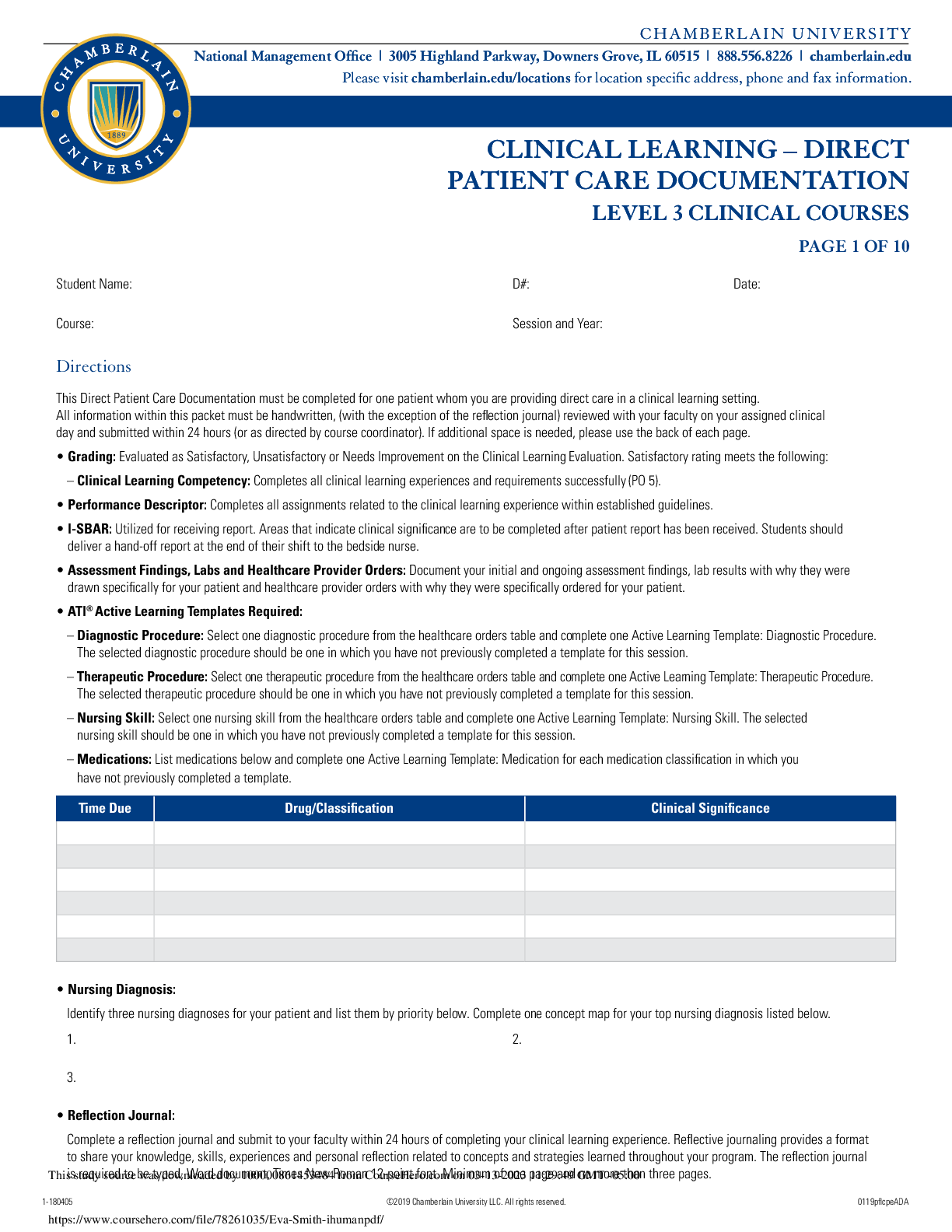
Buy this document to get the full access instantly
Instant Download Access after purchase
Buy NowInstant download
We Accept:

Reviews( 0 )
$9.50
Can't find what you want? Try our AI powered Search
Document information
Connected school, study & course
About the document
Uploaded On
Mar 13, 2023
Number of pages
9
Written in
Additional information
This document has been written for:
Uploaded
Mar 13, 2023
Downloads
0
Views
88


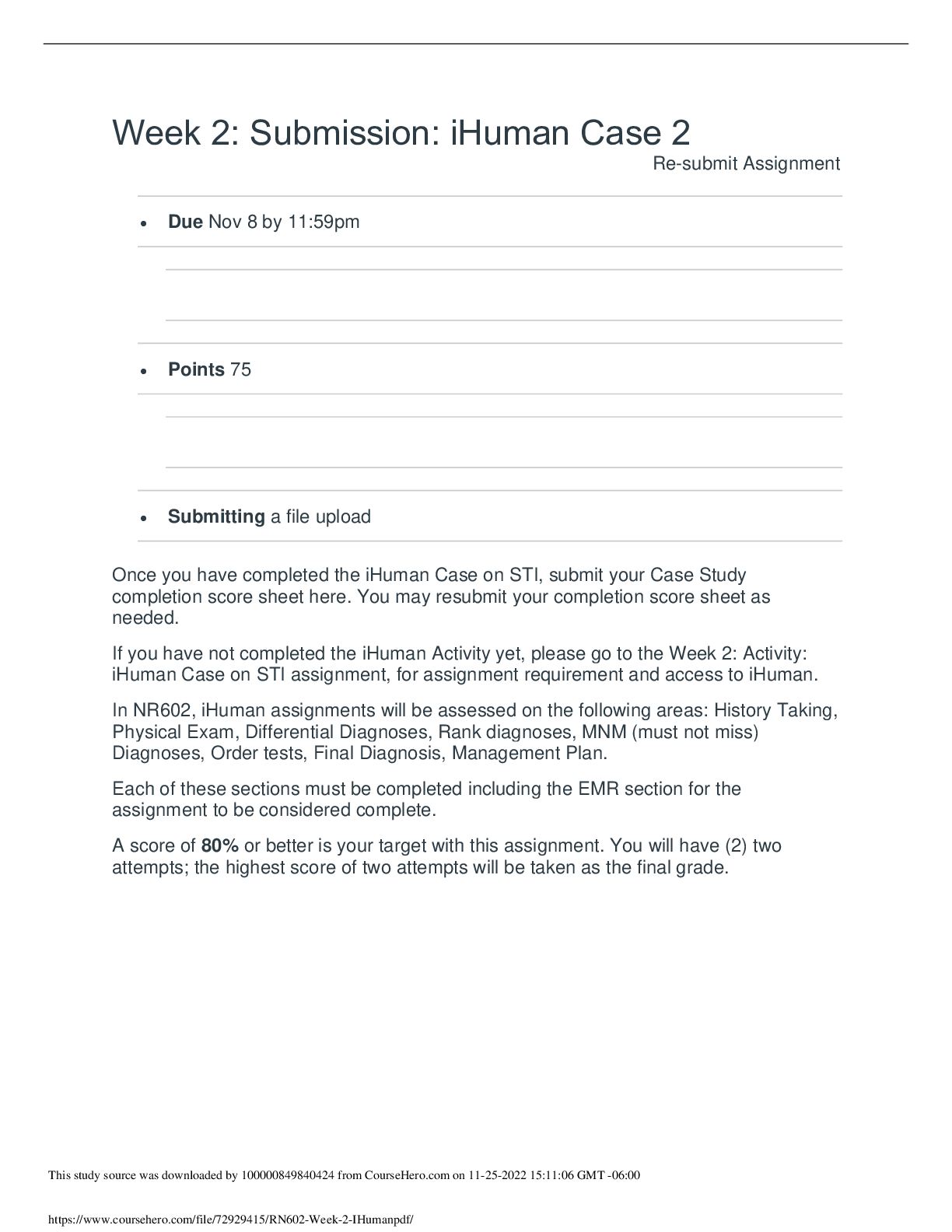
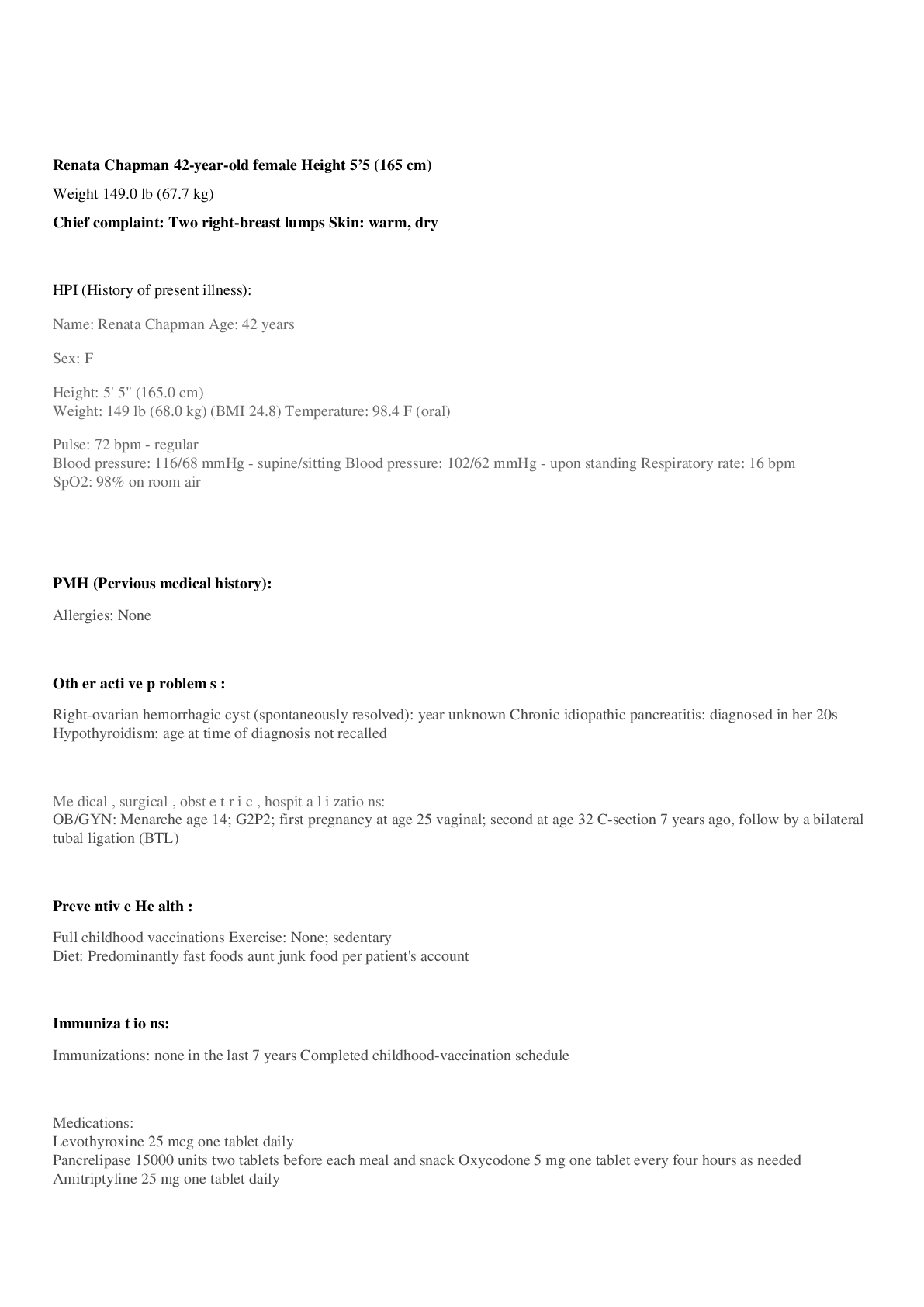
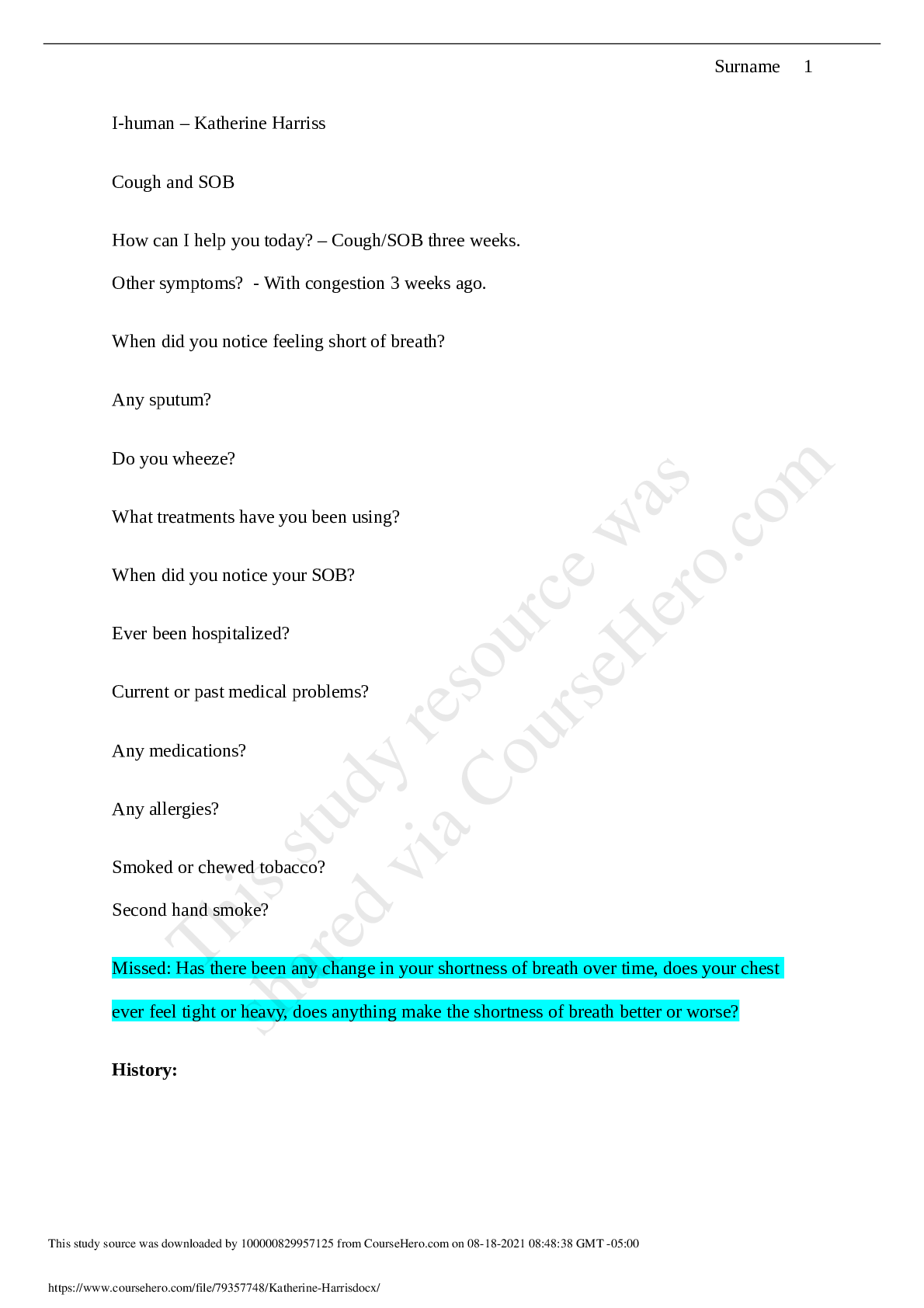
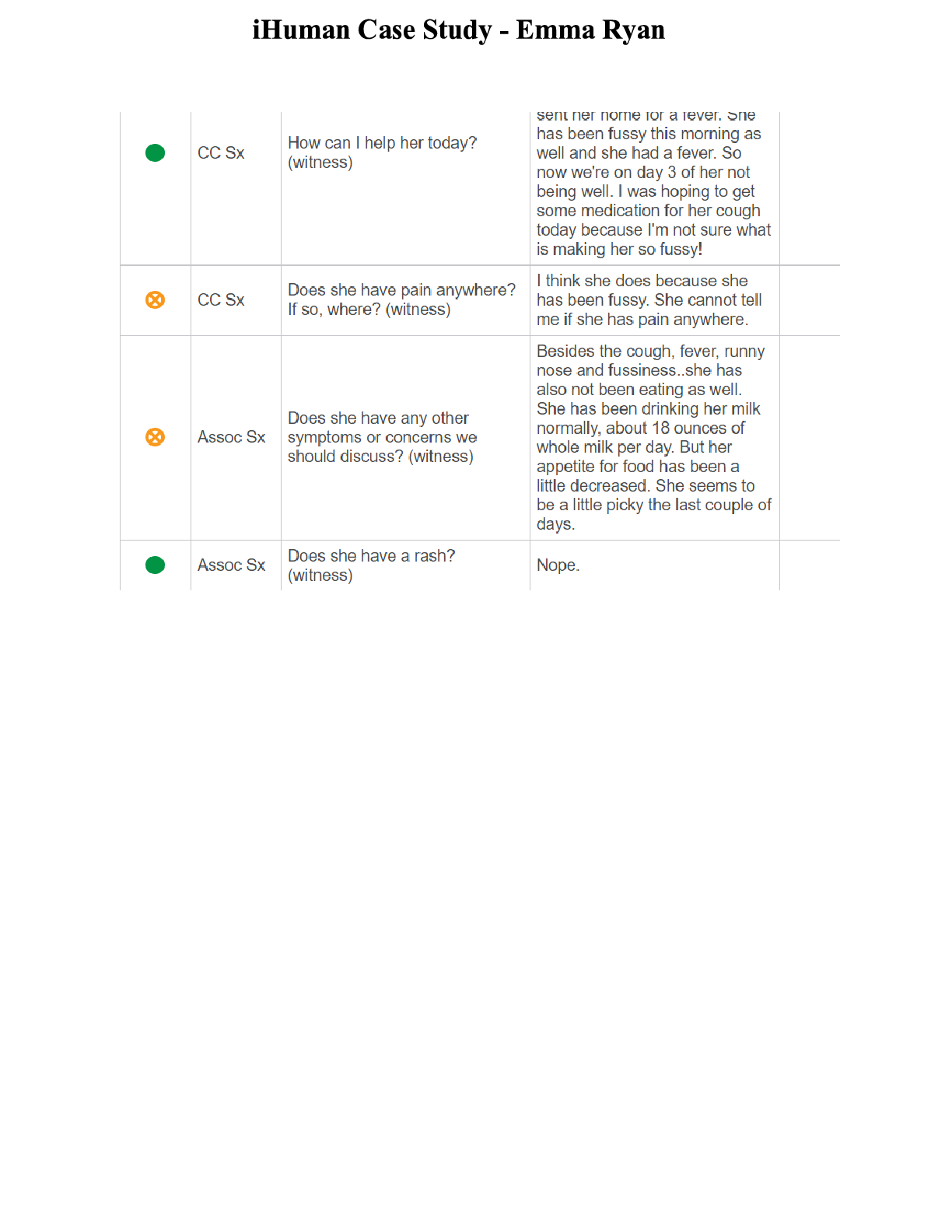

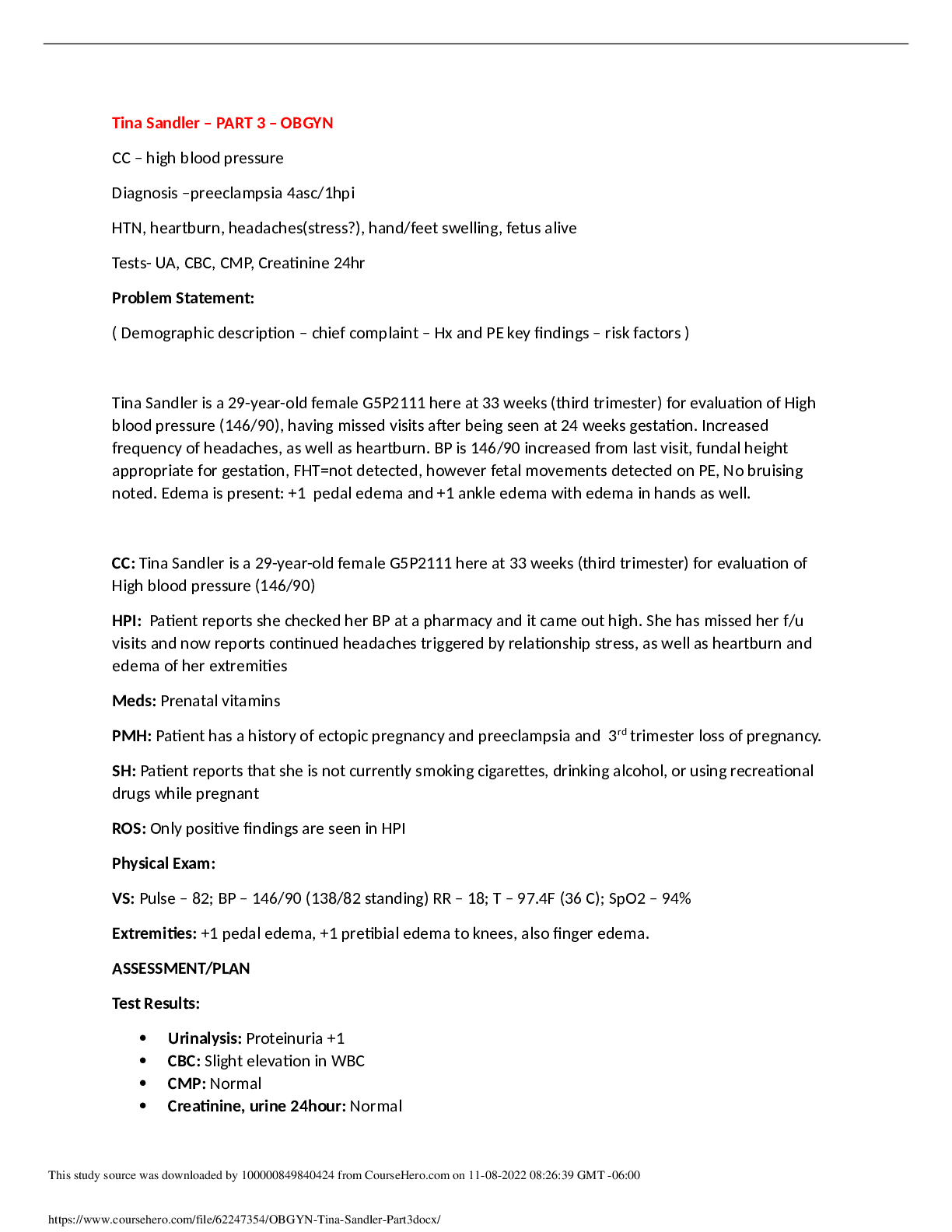




.png)

